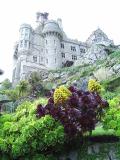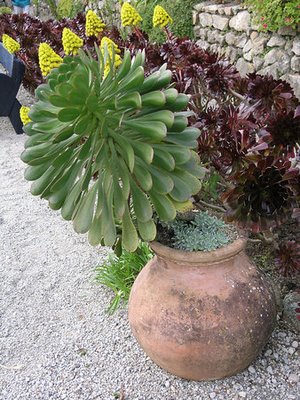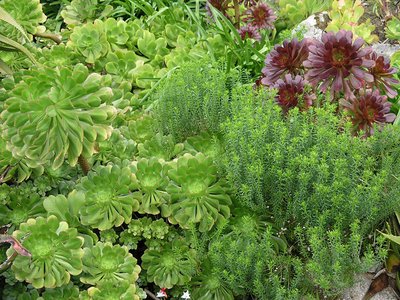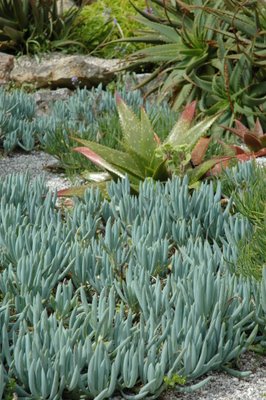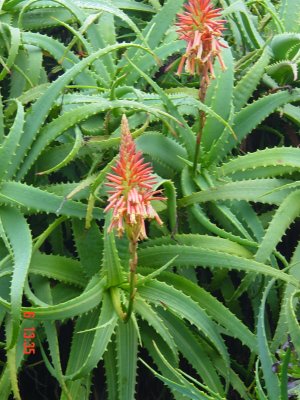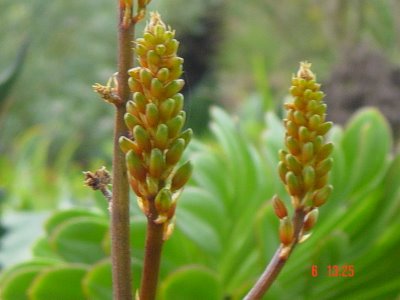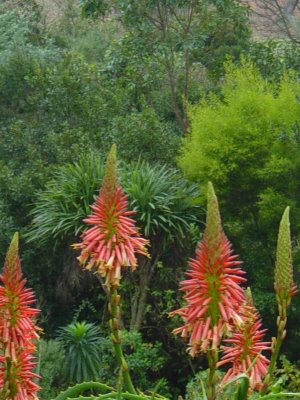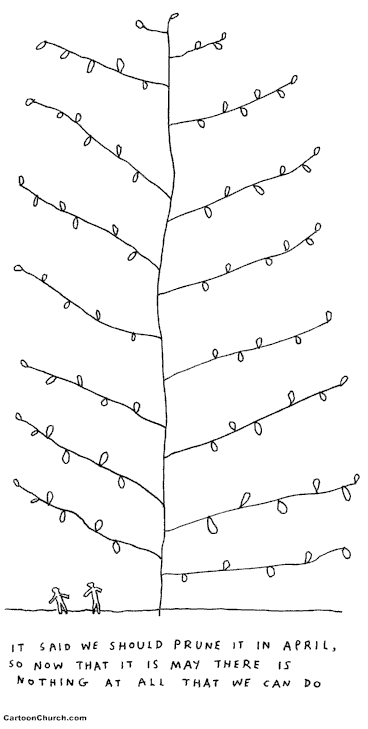 This is the story of the eucalyptus tree growing out of my decking - turn your back for a minute . . .
This is the story of the eucalyptus tree growing out of my decking - turn your back for a minute . . .Thursday, June 29, 2006
Pruning
 This is the story of the eucalyptus tree growing out of my decking - turn your back for a minute . . .
This is the story of the eucalyptus tree growing out of my decking - turn your back for a minute . . .Meudon, Mawnan Smith

orange bark, from
Finding this garden was a pivotal moment for me – there were no signs announcing its existence. There was no activity at all (I have since been back a dozen times at least, and have yet to meet another soul). The garden seems to just sit there quietly, having been carefully laid out and planted over a hundred and fifty years ago. Since this ‘discovery’ (and after reading The Origin of Plants), I wanted to find out more about Cornish gardens, plant introductions and the people behind them.
Tuesday, June 27, 2006
Abbey Gardens, Tresco, Isles of Scilly
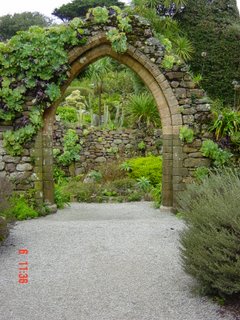
I recently went to the Abbey Gardens on Tresco, the Isles of Scilly. I was doing some research on succulents in Cornwall, as well as having a great time. Tresco is beautiful. The sand is fine, the sea is turquoise, the gardens are exotic and the people are so friendly. We stayed at the Island Hotel, details at: tresco.co.uk. Our room had a wonderful view of the sea and the food was fresh and delicious. We rented bicycles to ride around the island. It was great way to get around as there are no cars - only a few mad, crazy golf carts and tractors. I have been several times and have never been disappointed. I highly recommend it, I want to go back again. Soon. Very soon.
Agaves
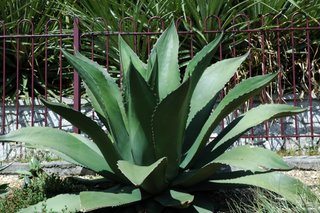
Agaves are also rosette growing, but on a much larger scale. They are part of the Agavaceae family and are thought to have originated from the deserts of North and
This beast is growing near the Falmouth seafront.
The larger members of this genus are commonly known as Century Plants, as they are very long lived and take many years to flower (typically up to thirty
There are three, large varieties that are found growing outside in the
Monday, June 26, 2006
Aeoniums
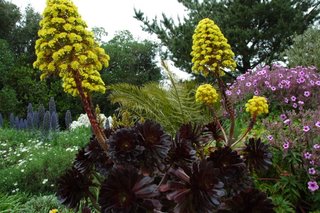
Aeoniums are a relatively small genus of multi stemmed, rosette growing plants from the Canary Islands, Madeira and
The inflorescence will have hundreds of yellow, pink or white flowers opening over a long period. A. cuneatum also stemless, but has a flower stalk shaped like pyramid, covered in yellow flowers.
Most varieties are bright green, except for the purple, deep maroon varieties:
A. arboretum var. ‘Atropurpureum’, or A. aboreum ‘Schwartzkopf’. These varieties are very decorative and can often been seen in large scale bedding schemes. Aeoniums have been included in this study as they have escaped and naturalized themselves all over the small
Echeverias
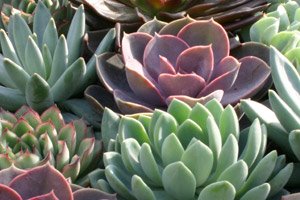
Echeverias are more tender, originating from the New World; from southern
A major difference between these two genuses is that Echeverias are polycarpic, meaning that they do not die once they have flowered. This genus produce rather large (in proportion to the plants themselves) bell shaped flowers that range in colour from yellow and orange to deep red. They flower
Echeverias are not as hardy as Sempervivums, not tolerating the cold well. Most temperatures below freezing will damage or kill them. They are also very sensitive to over watering; their roots must be in free draining soil. They do not like water on their leaves. Care should be used when handling certain Echeverias, as oil from one’s hands can leave marks on their leaves. Light is also essential for this genus, plants growing in low light will be tall and spindly, suffering from etoilation (lack of light).
Sempervivums
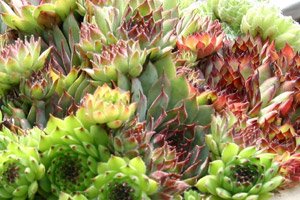
Sempervivums are alpines from North Africa, Europe, and parts of
These plants hybridize easily – if two plants flower at the same time, there is a good chance that their seed will grow into a new variety. There are approximately 35 species of sempervivum, but countless numbers of hybrids and cultivars. Many of these hybrids are unnamed and are of unknown parentage.
Succulents for the Garden
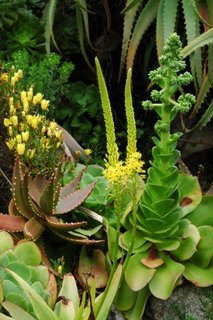
Water is front page news, whether too much or too little. Global warming is happening; the evidence surrounds us. Water shortages, hosepipe bans, water metering and domestic water consumption are issues that are not going away.
Hosepipe bans are already in place throughout much of South East England. Information on drought resistant plants and water
conservation has become readily available from gardening programmes on television and radio, gardening websites, as well as magazines and newspaper articles. Chelsea Flower Show is beginning to reflect a growing interest in water conservation in the garden as well as the use of drought resistant planting schemes. Succulents can play a significant role in gardens that are designed to use less water.
These succulents are growing outside in the Abbey Gardens, Tresco, Isles of Scilly.
Succulents have developed unique ways of storing water. In periods of temporary drought, they are able to draw on reserves, unlike many other plants communities which would quickly wilt and die without water.
They are incredibly versatile, and adaptable to container gardening, requiring very little care or maintenance whilst providing an interesting and varied display.
The Origins of Plants
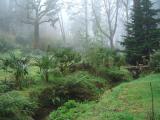
The Origins of Plants by Maggie Campbell-Culver, is a great book that talks about how plants from all over the world came to live in England. After the last Ice Age, Britain had the smallest natural, native flora of any country in the world. Yet, by the twenty first century is has the widest range of plants in the world.
Cornwall has been especially effected by the introduction of many species, which have become naturalized aspects of the landscape. This photo is of Tregrehan, St Blazey, near St Austell. It has a vast collection of plants from the southern hemisphere.
When looking at these plants I cannot help but think of the places from which they came, the plant hunters that brought them here, as well as the plant collectors that nurtured them.
Cornwall has a mild climate, not too hot and not too cold with plenty of rain. These conditions are not always welcome by holiday makers and beach goers, but they are perfect for plants from lush rain forests. Cornwall can also sustain a wide range of plants from dry environments as well.
The Cornish Experience
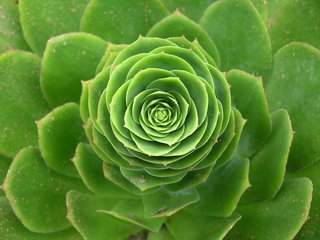
I have lived in Cornwall for eleven years. I have loved it and hated it in equal measure
I am somewhere in the middle at the moment. But I am still here. And I am still gardening.
I love Cornish gardens. They are incredibly diverse, wild and full of history.
My blog is about gardening and life in Cornwall.

